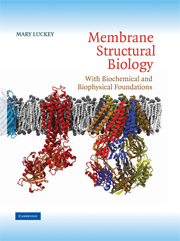Book contents
- Frontmatter
- Contents
- Preface
- 1 Introduction
- 2 The Diversity of Membrane Lipids
- 3 Tools for Studying Membrane Components: Detergents and Model Systems
- 4 Proteins in or at the Bilayer
- 5 Bundles and Barrels
- 6 Functions and Families
- 7 Protein Folding and Biogenesis
- 8 Diffraction and Simulation
- 9 Membrane Enzymes and Transducers
- 10 Transporters and Channels
- 11 Membrane Protein Assemblies
- 12 Themes and Future Directions
- Appendix I Abbreviations
- Appendix II Single-Letter Codes for Amino Acids
- Index
- References
12 - Themes and Future Directions
- Frontmatter
- Contents
- Preface
- 1 Introduction
- 2 The Diversity of Membrane Lipids
- 3 Tools for Studying Membrane Components: Detergents and Model Systems
- 4 Proteins in or at the Bilayer
- 5 Bundles and Barrels
- 6 Functions and Families
- 7 Protein Folding and Biogenesis
- 8 Diffraction and Simulation
- 9 Membrane Enzymes and Transducers
- 10 Transporters and Channels
- 11 Membrane Protein Assemblies
- 12 Themes and Future Directions
- Appendix I Abbreviations
- Appendix II Single-Letter Codes for Amino Acids
- Index
- References
Summary
The 2003 Nobel Symposium on Membrane Proteins presented progress based on a vast amount of work characterizing membrane proteins, including many of the proteins described in preceding chapters. For decades the methods of biochemists, biophysicists, geneticists, and cell biologists provided a wide range of techniques to probe the structural basis of how membrane proteins function. When crystallographers turned their attention to membrane proteins, it took over a decade to solve some of the first crystal structures and provide the long-awaited high-resolution structures. These first glimpses of their beautiful structural details changed the level of comprehension of membrane proteins, providing new insights into their mechanisms of action. Now that dozens of membrane proteins can be viewed at atomic resolution, recurring themes can be identified that are likely to engage structural biologists focusing on membranes. This last chapter not only summarizes these themes, which occurred throughout earlier chapters, but also points out directions for future work as it considers what the current high-resolution structures are revealing about oligomerization, different conformational states, and structural patterns of membrane proteins.
OLIGOMERIZATION
The majority of the proteins discussed in this book, and indeed most of the membrane proteins for which there is a high-resolution structure, form oligomers. Even the monotopic prostaglandin H2 synthase forms dimers that are the active state. It is important to determine the oligomeric state of membrane proteins, whether enzymes, channels, or receptors.
- Type
- Chapter
- Information
- Membrane Structural BiologyWith Biochemical and Biophysical Foundations, pp. 309 - 314Publisher: Cambridge University PressPrint publication year: 2008



